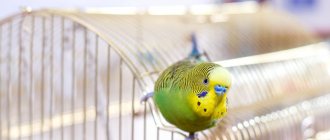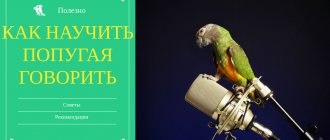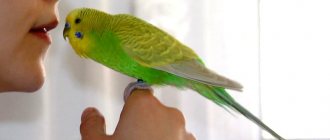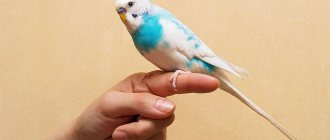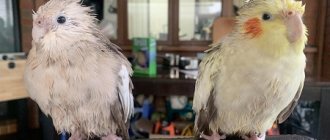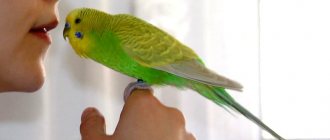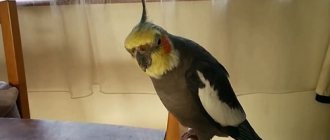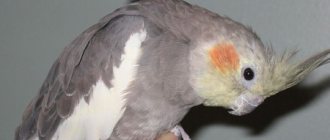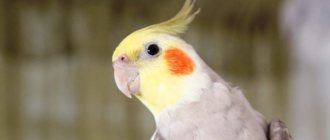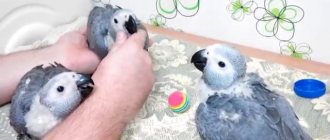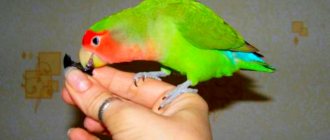It makes sense to think about how you can tame a cockatiel already at the purchase stage. There are behavioral features of ornamental birds, depending on age. How to choose a parrot that will quickly become tame, and what conditions should be created for it? We'll tell you about taming a cockatiel step by step, based on the basic nuances of parenting.
Which birds are best tamed?
You can quickly tame a cockatiel if it is still a chick. The entire process will take 1–2 weeks.
Important! Under natural conditions, small parrots are protected by their mother for 6 weeks. Then they leave the nest.
The optimal age for purchasing a chick is 2–3 months after birth. In this age range, a person will be able to make friends with a cockatiel without any problems. The young animals do not yet have life experience, but with a good attitude they quickly get used to the owner, imitate everything, and study the world around them with interest. He lends himself well to learning and boldly makes contact.
To quickly tame a small parrot, you need to pay attention to it. You can't leave him alone for a long time.
It is difficult to tame chicks that previously lived in a flock. They prefer to communicate with other birds and do not want to perceive humans. These cockatiels need time to adapt.
It is much more difficult to tame a cockatiel as an adult (from 1 year). The bird's character has already been formed; it is more difficult for it to perceive new surroundings and people.
You should not hope that a nymph who has already had experience communicating with people will quickly get used to the hands, especially if it was negative. Even if the relationship with the previous owner was warm, the bird needs time to get used to the new place, sight, voice and smell of the owner.
If a person has previously offended or beaten a feathered pet, then he simply does not have trust in other people. The last option is the most difficult, since you will have to spend more than one month to tame a parrot, and also arm yourself with perseverance, patience and goodwill.
Those who want to accustom an adult nymph to their hands need to be prepared for the fact that representatives of this breed do not like to adapt to the character of people. The birds themselves dictate their requirements to the new owners. In addition, the cockatiel's attitude towards people depends on different periods of life.
Before buying a parrot, you need to check with the seller the following nuances:
- attitude towards people (fear or openness);
- health problems;
- diet;
- character traits;
- attitude towards bathing;
- behavior alone (playing or sad);
- daily regime;
- presence of neighbors (other pets) from the previous owner.
New owners of an adult cockatiel may be in for an unpleasant surprise in the form of bad habits. Then you will have to spend time eradicating them. But this must be done gently.
Pet character traits
The task of taming will be difficult if the exotic bird has already formed its character. Previous experience of communicating with a person may not have been in a positive way.
Read also
The parrot has become ruffled and hides its head under its wing
. Having bought an adult parrot, you may encounter bad habits, thanks to which the previous owner was in a hurry to get rid of it.
It is impossible to predict how events will develop further.
How to tame a cockatiel
You need to start training on the first day your pet arrives at home. To accustom your cockatiel to being handled, training should be done daily. These birds are smart and inquisitive, they quickly learn new skills. Therefore, patience and systematicity are the main components of success.
When studying at home, you should not rush things, lessons should be short and the atmosphere should be calm. Then nothing will distract the cockatiel, and he will not get tired from studying.
The owner must be prepared for the fact that at first the parrot will be hostile towards him (especially an adult). This is due to the fact that when the situation changes, he experiences stress. Then the bird sits in one place for a long time or flies chaotically around the cage. When a person approaches, it presses or raises its crest, flaps its wings, makes loud sounds, and tries to bite.
In this case, taming a cockatiel should be done step by step:
- adaptation;
- establishing contact;
- towel training;
- learning tricks.
If you organize the classes correctly, then within a few weeks the owner will be able to tame a cockatiel parrot.
Brief information about the new friend
The bird is considered unique in its kind in the cockatoo family, common in Australian territories. A distinctive feature of nymphal cockatiels is a large and bright crest on a movable head. The main features of individuals:
- a medium-sized bird with a long, flat tail, a strongly rounded beak, and large paws;
- females and males have different colors of plumage and crest, the male is brighter than the female;
- the main color is gray or olive with transitions to various colors;
- The cockatiel's cheeks are decorated with orange-red spots;
- breed well in captivity (see breeding cockatiels at home);
- capable of flying long distances in their habitat.
Adaptation
To tame a small parrot, all you need to do is feed it and care for it. With an adult, everything is more complicated - it is necessary to go through the process of getting used to the new environment and people. The owner of the bird must create favorable conditions for its adaptation.
Socialization of an adult cockatiel step by step:
- Peace and quiet. In order for your pet to get used to its new home, you need to create a calm environment around it. During the first stage of adaptation, you should give up loud music, talk quietly, and avoid sudden movements near the cage. After a few weeks, the bird will get used to the new place, then it will begin to examine the room and people with interest.
- Heart-to-heart conversations. At the second stage of taming, the owner must talk to the pet. You can say various endearments or simply tell stories, the main thing is that the tone is calm, pleasant and quiet. It is important to avoid sudden changes in volume and gestures. The face should be at the level of the bird, then it will perceive the person as an equal. After just a few days of such conversations, the nymph will no longer be afraid of the new owner.
- Check connection. At the 3rd stage of taming, you should make sure that the cockatiel is accustomed to the presence of a new owner. If this is so, then the bird will look at the person with interest, listen to the voice, and come closer. Right now you can start teaching him to speak, but gradually.
- Treats. To make your pet get used to the person faster, you can treat him with special food or spikelets of millet. You need to pour some treats into your hand and hand it to the bird. But you should maintain some distance so that the bird itself approaches the hand. Do not move your hand so as not to scare your pet. Let him treat 1-2 times or eat for about 5 seconds. If the cockatiel tries to bite, then take your hand away, but gently.
Interesting! You should choose one treat (such as honey sticks) for your cockatiels, which is used only as a reward. That is, it should be given only after the parrot carries out some command.
Taming a nymph will be successful if all the above steps are performed every day. It is enough to allocate 10–15 minutes for classes. After successfully completing specific actions, the cockatiel must be treated. Encourage her to come closer to your hand for a treat. You should not conduct classes longer than 15 minutes, even if the parrot seems to be behaving well. Young birds need to eat and rest more often.
Get closer
About two weeks after the start of adaptation, the parrot will be ready for the next phase of taming. No need to rush. Make sure that the bird no longer gets scared or upset at the sight of people. When the rooster is not stuck in the corner of the cage, but is watching our movements with curiosity, we can try to accustom him to our hands.
Attention! The nature of cockatoos changes over time. In a few years it will be a different parrot: self-confident and maybe even aggressive. We'll have to go back to the basics of parenting.
Enter from the side of the feeder
A taming method that has been proven over many years of experience is to reward parrots with food. To strengthen a trusting relationship, the parrot is treated to:
Attach a treat between the bars of the cage and then wait for your betta to become interested and approach. Soon he will be brave enough to start pecking food out of his hands. Now you can open the door and draw your hand with seeds, nuts, and berries. The bird should get used to people and safely take food from hands while sitting on perches. It is important not to miss the right moment: try to land the bird on your finger.
Get used to your hands
So the parrot trusts its owner and looks forward to communicating with him. It's time to take the next step. It is better to do this in the morning, when the animal has slept well and is hungry. By sticking your hand with a treat into the cage, we let the bird superficially satisfy its hunger. Gradually remove your hand, forcing the cockatiel to go for food. Then make a tricky gesture: run your finger along the nymph's belly. With a slight loss of balance, the cockatiel staggers and steps on its toe. This is the key point. The bird may be scared, but may enjoy its own bravery.
All actions must be accompanied by encouraging words. The bird should be praised for every success. When he sits on the hand, he can check the back of it with his bow. It takes a lot of stamina to not tear your hand off after being bitten. Negative human reactions are very detrimental to establishing friendships. The parrot cannot be weaned, otherwise there will be feedback and trust will have to be won again.
To have a break
If the bird is afraid of being caught in the hand, experiments should be postponed. However, you should not interrupt your daily feeding ritual. Raise your winged friend in the same way, but do not touch him with your hands. After two to three days, return to the previous step. Alternatively, change your tactics and offer a toy. The addition will definitely interest the parrot, especially if it is a young cockatiel. Chicks, like babies, learn through play. Trust will soon be restored.
Contact with a parrot
When the owner is convinced that the cockatiel is comfortable in his presence, he can teach it to sit on a finger or hand. This can be understood by the following signs: the bird is calm when a person approaches, it takes food from his hands, looks at him with interest. Once this level of trust has been achieved, you can begin to open the cage.
The owner can use treats to encourage the bird to come out. However, adults may refuse this.
Attention! Before opening the cage, you need to take the necessary safety measures: close the windows, doors, remove other pets (cats, dogs) from the room.
The cockatiel will get used to your hand if you exercise regularly. You need to gradually reduce the distance between the bird and your hand. Over time, she will begin to independently approach the hand to feast on it. At this stage of taming, you can remove the food and try to smoothly move your hand closer, holding out 2 fingers (as in the photo above). You need to freeze for a while for the cockatiel to calm down. Don't forget to reward calm behavior. Classes are held 1–2 times a day.
When trusting contact between the cockatiel and the person is established, you should encourage her to sit on your finger. First you need to bring your hand to the perch and gradually reduce the distance between your finger and the bird. Decisive action should be taken when the hand ceases to cause concern. Then you can touch the nymph’s paws, lightly push her in the lower abdomen so that she loses her balance and steps on her finger with one paw. This technique will need to be repeated several times.
To tame a bird and teach it to sit on your fingers, you need encouragement. Each time he climbs onto your hand, you should repeat the command “sit down.” After completion, be sure to treat the nymph with treats. The bird that stepped on its toe with both paws deserves even more encouragement.
Important! The owner of a cockatiel should be prepared for the fact that she may pinch his finger. It is important to refrain from screaming or making sudden movements so as not to scare the bird. In this way, she checks the reliability of the support on which she stands.
When the parrot becomes tame and can easily follow the “sit down” command, you can try to teach it to move to the other hand, and also to walk up a small ladder. To transfer the parrot to the other hand, just say “sit down” and insert your fingers. To teach him to walk on a ladder, you need to clearly pronounce the word “ladder”.
Classes should be carried out until the cockatiel begins to follow commands without additional encouragement.
Gain trust
Greenland birds must be raised so that they do not experience disobedience. Before you start teaching your parrot the principles of life, you need to earn his trust. Whether this will succeed depends not only on the owner, but also on the animal. All birds are individual: each has its own character, abilities and experience. There is no single method for taming cockatoos, but general recommendations from breeders exist. The first step to a good relationship is to adapt to the new environment.
Speed up adaptation
On the first day after the move, the bird is clearly worried. This time is absolutely not suitable for taming and getting to know all family members. You should not immediately put your cockatiel in an enclosure with other feathered animals - this will cause double stress for her. For a beginner, you should prepare a separate, well-equipped cage located in a convenient location. It should not be placed next to a TV, refrigerator or computer. Preferably in a corner where the cage is closed on both sides - so that the rooster feels safe.
If possible, the room should be closed. Release it only to those who plan to train the parrot in the future. The bird will calmly look around, getting used to its environment.
Spend time together
By providing the pet with a favorable environment, the owner can offer him unobtrusive communication. At first, this is the usual presence of the cockatoo during waking hours: reading a book, light cleaning. While near the cage, speak kindly to the parrot, calmly approach it, and clearly say its name. Smooth and calm intonation is good for the cockatoo’s psyche. A smart parrot understands that a person is not an enemy, he can be trusted.
This distance is decreasing daily. When communicating, it is important that the eyes are at the same level so that the bird feels more confident. It is better to keep your hands close to your face, for example, resting your hand on your chin. Do not take him out of the cage and do not let him go for a walk. The nymph, frightened by space, will begin to hit the window and may get hurt. You will have to catch him and return him to his place. Then, instead of asking how to quickly tame a cockatiel with a weapon, the task arises of bringing the bird out of shock.
Towel training
The cockatiel taming program includes teaching it to use a towel. This is necessary in case the bird gets sick and has to be taken to the vet. This skill is also useful for dangerous situations (fire, gas leak).
You need to teach your cockatiel to respond normally to being wrapped in a towel. If contact with the owner is established, and the bird feels calm in his company (including outside the cage), then classes can begin.
To accustom a nymph to a towel, you need to follow this plan:
- A white or beige towel is spread on the floor.
- The bird is placed in the middle of the product and given time to get comfortable.
- Gradually you need to raise the corners. If the pet begins to worry, then you need to lower them and stop training.
- If the bird remains calm, then you can raise them higher to hide it entirely.
Bird behavior depends on productive sleep
Excitability is directly related to how long the harmful cockatiel sleeps. For normal functioning, he needs 10 hours of quiet, deep sleep.
When a cockatiel sleeps, the following rules should be observed:
- Turn off the radio and TV during daytime naps.
- Cover your pet's cage while sleeping at night to prevent light and sounds from waking him up.
- Protect the bird from harsh sounds.
If the bird gets a full 10-hour sleep, you won’t have to wonder why the parrot is lethargic or excitable in the morning.
Performing tricks
When taming a parrot, experts advise using a clicker (a device that makes a clicking sound). Training using this device is more effective. It is necessary, because over time the commands will become more complex, and then the bird will no longer understand for what actions it receives treats.
The clicker makes a specific click that cannot be confused with any other sound. You must press the button on the device every time the command is executed, and immediately serve the treat. When the cockatiel automatically performs the desired actions, you can use only the clicker (without treats).
As part of the taming program, a nymph can be taught to speak. The optimal age for classes is 8 months. It is difficult to teach an adult to speak. You can start training at 4 months, if the chick reacts with interest to human speech.
Interesting! Male cockatiels learn speech faster and pronounce words more clearly. This is due to the fact that in nature they attract females with complex sound combinations. Females will also be able to speak, but they will pronounce their words less clearly.
Lessons are carried out if the cockatiel is in a good mood. You need to choose a simple short word and repeat it syllable by syllable, the pronunciation should be clear. If the cockatiel tilts his head and his pupils dilate, this indicates his interest. You should repeat the word almost without stopping, look at the parrot, and when he tries to repeat it, give him a treat.
Handling a cockatiel will become more fun if you teach the bird to dance and whistle. It is necessary to turn on the music (not very loudly), shake your head to the beat, gesticulate with your hands, imitate the movements of the conductor. When the bird begins to repeat after the owner, you should click the clicker and give him a treat. While playing music that is attractive to the parrot, it can move more actively and open its wings.
A little later, during the dance, the owner can whistle a melody or play a recording with a distinct whistle. The bird will probably want to repeat this sound.
Bathing
This parrot really loves water treatments. They bring him great pleasure and are therefore absolutely necessary. How to bathe a cockatiel parrot at home? There are three options to solve this issue:
- Place a special bathing suit in the cage. This could be a small plastic bowl filled with water. The bathing suit should always be in the pet’s field of vision. The parrot will take a bath himself whenever he wants.
- The owner can wash the tamed bird himself under the tap. The stream should not be strong and the water should be warm.
- Use a spray bottle. The water, again, must be clean and warm.
How to tame an adult cockatiel
The process of taming an adult bird is no different from training chicks. Here, too, it is important to be patient and not to rush. If a person suddenly climbs into the cage and tries to forcefully get the bird, he will provoke aggression. Then the bird will lose trust in its owner for a long time.
Taming should take place gradually:
- During the adaptation period, you need to be near the cage more often to encourage the cockatiel to observe. If she calmly eats, drinks water or chirps in the presence of a person, then this indicates a certain degree of trust.
- When the bird looks at the person with interest, he may begin to talk to her.
- You need to observe which food the nymph likes best; this knowledge is used in the process of taming. These can be seeds (pumpkin, sunflower, flax), sweet berries, pieces of banana, apple, pear, orange slice. Corella will not refuse carrots, cucumbers, and tomatoes.
- You should try giving treats to your cockatiel through the bars of the cage. If she is interested in the proposal, then this action should be repeated daily. After mastering the skill, you can teach the bird to eat from your hand. It is better to do this in the morning before meals.
- At the next stage of hand taming, the nymph is taught to sit on the fingers.
- You can tame a parrot with the help of toys. They are naturally curious, especially the young. To make friends with your pet, lure it with bright balls, feathers, and jingling bells. The main thing is that the item is small and colorful.
Taming toys
described above is suitable for both adults and young chicks . But taming with food is more effective for adults, but a young bird will get used to being handled much faster with the help of toys, especially if it is inquisitive, impressionable and shows interest in the world around it.
The only thing that can slow down taming is the need to determine what kind of entertainment your bird prefers. So, some individuals are interested in shiny objects, while others are attracted to toys that make sounds (for example, bells).
Surprisingly, among cockatiels there are also real “intellectuals” who are more interested in complex designs in the form of beads strung on a thread.
In any case, here you will also have to first go through the stage of habituation and instilling trust in the bird, and then, instead of food, attract the bird with a toy (feeding is carried out as usual).
Possible difficulties and errors
The main difficulty in taming a cockatiel is that as it grows, its character changes. At some stages of life they become especially aggressive and self-confident. But the owner’s patience will help overcome the age crisis.
When taming a nymph, the following mistakes should not be made:
- force events, hope for a quick result;
- do not pay attention to the pet’s mood and condition;
- perform actions against the will of the cockatiel;
- wave your arms sharply, shout, roughly grab or even hit the bird;
- turn on household appliances with a sharp loud sound near the cage;
- conduct classes several days a week rather than daily;
- have other people take care of your cockatiel while it is being tamed;
- forget about praise and encouragement;
- As a punishment for bad behavior, go on hunger strike to the parrot.
These actions will have a bad effect on the cockatiel, then at best the taming process will be delayed, at worst the bird will completely lose trust in the owner, will show aggression or even get sick.
Golden rules of training
Moral part
The pet will perform only those tasks that it likes. If a parrot flatly refuses to do something, then these actions are not suitable for him. Not a single treat in the world will help you if your cockatiel is stubborn. In such cases, it is better not to torture yourself or the bird and move on to another task.
Don't expect your parrot to do the exercise the first time. This will require time, patience and strength on both sides. If something doesn’t work out for your pet, don’t even think about yelling at it, banging on the cage, or even hitting the bird. Otherwise, the bird's trust and your friendship will end.
So that the parrot can concentrate on his lessons, he should not be distracted by anything. Therefore, there should be complete silence during training.
Always end your workout on a positive note. If something doesn't work out for your pet, don't force it. It’s better to repeat with him the commands that he understands. Then reward the bird with a tasty treat and a kind word, and scratch its back. This will keep the lesson positive.
If you are not in the mood, it is better to postpone the lesson. You will quickly get tired and risk losing your temper with your pet. Yes, and the parrot can feel your irritation and show aggression.
If the cockatiel is tired and has not had enough sleep, then training should be abandoned. If the bird is sick, then it must first be cured, and then given two weeks to recuperate. And only then continue training.
Duration and sequence of classes
Manage your training time correctly. Allow no more than fifteen minutes for each lesson. There should be about two to three lessons per day. If you increase the duration and frequency of exercise, the cockatiel will get tired. A tired bird is not interested in your tasks, it wants to sleep.
Do not force your cockatiel to perform several tasks at once in one day, do not rush or rush him. He will not be able to concentrate, which means he will not cope with the task. Training must be consistent. Learn one command first, no matter how long it takes. Only after your pet has accurately followed the command can you move on to learning the next one.
Preparing the place for classes
Before each workout, make sure the room where it will take place is safe. Remove everything that poses a danger to the parrot: wires, plants, small items, ashtrays, markers, glue, etc. Close windows and doors, remove pets.
You need to allocate a place in the room for training. Cockatiels prefer familiar objects that give the parrot a sense of security. In the chosen location, you can install a play stand with bird toys. When the parrot explores the training area and makes sure it is safe, the lessons will go faster and more effectively. Instead of a stand, you can put a regular chair.
If during class the cockatiel gets distracted or starts playing, the lesson should be paused and the parrot should be given time to calm down. Leave him alone by leaving the room and closing the door behind you. Alone, the bird will return to normal in just a couple of minutes. Now you can continue your workout.
Sometimes the bird gets distracted and even flies away because it does not like the place you have chosen. There is no need to force her back. It's better to change your training area.
Fighting bites
New or future parrot owners need to know what to do when handling a parrot if it bites and is afraid. It is necessary to understand that the bird does this because it feels threatened by the person and does not trust him.
If the cockatiel begins to bite during taming, the owner should react as neutrally as possible. Do not suddenly withdraw your hand, cry out, or urgently finish classes. This reaction may encourage the cockatiel to attack its owner in the future. The bite is painful, but you must try to restrain yourself.
Important! If the cockatiel hisses, raises its crest high or presses it, then it is preparing to attack. Therefore, it is better to gently remove your hand from the bird and allow it to calm down.
If the owner is trying to tame a cockatiel and it constantly bites and is afraid, then you need to think about protecting your hands. It is better to carry out classes with thick gardening gloves to slightly reduce the pain from the bite.
You cannot punish a nymph for biting and being afraid. The bird still won’t understand why a person yells at it or hits it. However, trust in the owner will disappear after such actions. It is better not to pay attention to such actions, deliberately ignore the pet or take away his favorite toy.
The owner should focus on rewarding commands and good behavior. Then the parrot's taming will speed up.
Release
Birds are born to fly. A pet parrot kept in a cage also wants to feel free. When the main stages of taming the cockatiel have passed, you can let them go for a walk. Before opening the door, secure the area as much as possible:
After preparing the room, open the cage and try to lure the parrot outside. One way is to place your hand near the bird and, when it calms down, slowly remove it. If your Corella is worried, don't rush her. You need to encourage your pet, and he will begin to flutter freely.
Attention! After a walk, the parrot must return to the cage on its own. It cannot be pushed or caught; it is better to lure it with the sound of food - and the hungry bird will fly back to its home.
Taming a cockatoo is interesting and educational. By interacting with a smart bird, a person changes himself and discovers new abilities. Coercion and punishment are not measures to be followed. Raising a feathered bird requires love and patience.
Reproduction
Breeding cockatiels at home is quite a feasible task even for a novice breeder. First you need to choose a good pair of birds. You need to install a nesting house in their cage. After mating, the birds begin to build a nest, and then the female will begin laying eggs.
Laying does not occur simultaneously, but gradually at intervals of about a day. In total there can be 3-7 eggs in a clutch. The incubation period lasts 21 days. All this time, the female almost never leaves the nest; most of the food is supplied to her by the male. He also takes part in incubation while the female lays a new egg or leaves the nest.
